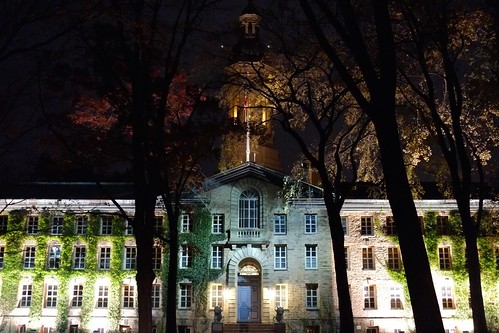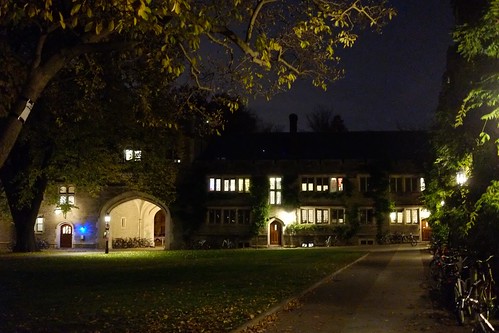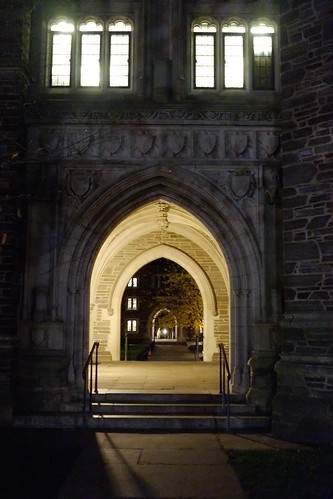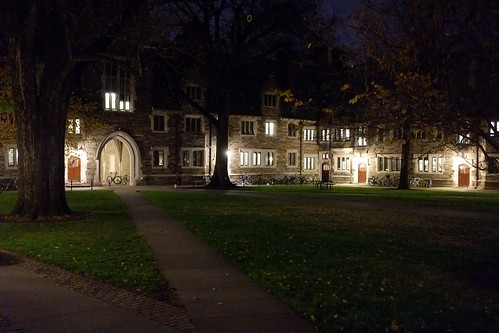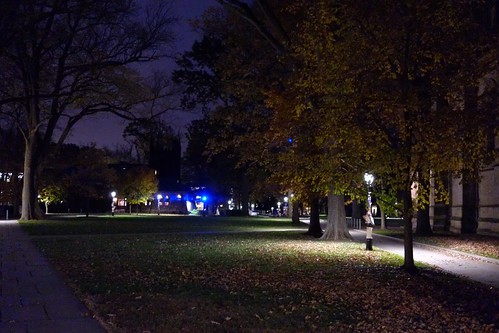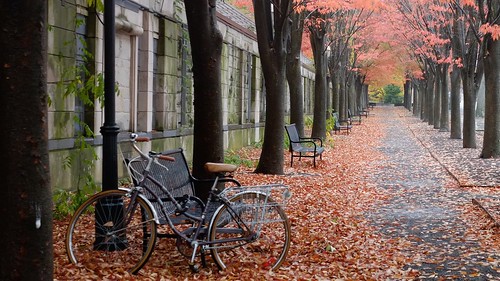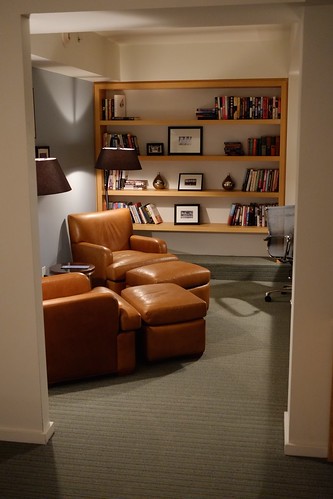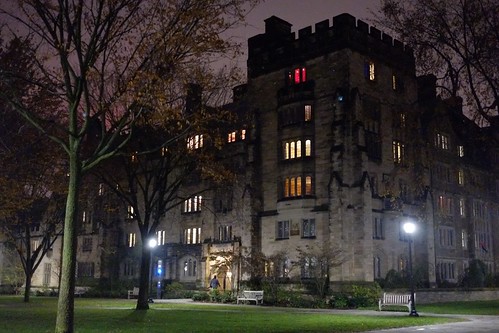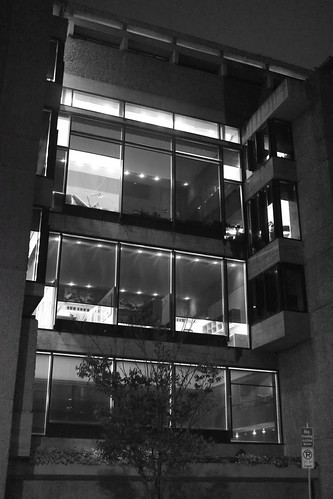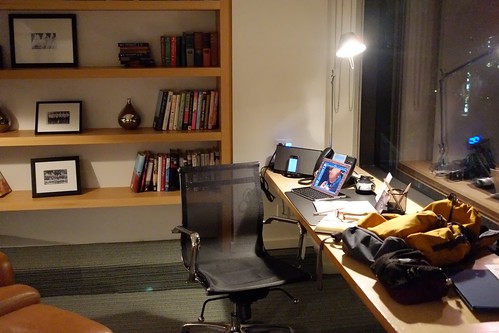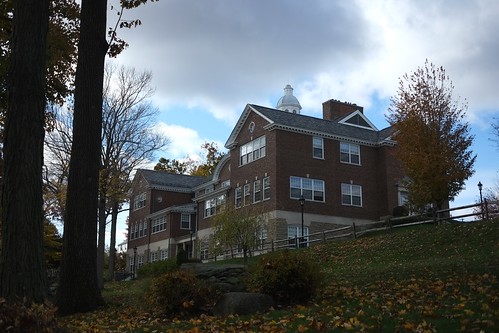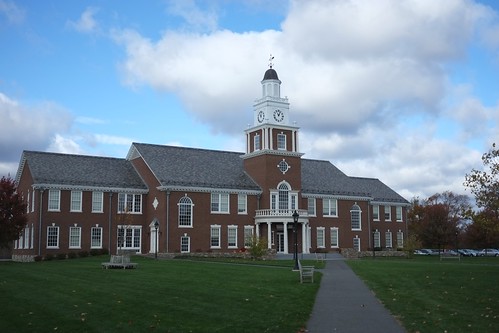Last week I spent several days on the road, on a whirlwind trip to the East Coast to talk about contemplative computing and The Distraction Addiction. It was just happy chance that I got two invitations to talk in the same week, and was able to make it work.
The first was in Princeton, at the Princeton Atelier, a project at the Peter Lewis Center for the Performing Arts that Toni Morrison started a few years ago. This fall theatre director Marianne Weems is teaching a class called “Pay Attention: The Art of the Here and Now,” and so I was invited to give a talk as part of the course.
I’ve not been to Princeton since 1999, when I gave a talk on corporate life and the life of the mind; so it was good to be back among colonial and collegiate Gothic buildings. I got there Wednesday evening, and after checking into the hotel, took my camera and went out for a walk.
After living in Cambridge, I expected to think less of the campus, but I found Princeton not to be a copy of Cambridge of Oxford architecture, but quite a different place: much less urban, more self-contained, and pleasing in its architectural unity. I think there are also some subtle but important differences in the way American architects interpreted Gothic that make it less a copy, and more distinctive and independent.
But mainly, Oxford and Cambridge are located in towns, and don’t have the amount of park-like open space that American campuses do. (They have plenty of land, but for the wealthier colleges the land is more like a portfolio of holdings than a single big expanse.) Downtown Princeton, of course, is right beside the university, but it’s separated by Nassau Street, and is not exactly the set of Low Winter Sun.
Princeton is also the darkest campus I’ve been in in a long time.
There are these Chronicles of Narnia-style lampposts scattered around, but compared to most campuses (like Penn, for example), it’s shadow-shrouded, and for some reason the cyclists all seem to think it’s cool to move around campus like Ringwraiths, with no lights or reflectors.
The next morning it was raining, and I needed to go over my talk, so I spent the morning at a coffeeshop on Nassau Street. I then had lunch with Marianne, and went over to the Lewis Center (a former elementary school on the edge of campus) to get ready for the talk.
The talk itself was good: I did a more academic version than usual (which I figured I could get away with given my location), and also worked in some of my argument about deliberate rest. I’ve recently realized how much it picks up on and extends some of the themes from The Distraction Addiction, while also breaking new ground and giving closer attention to some things that I didn’t talk about in detail. So when I have time, talking about them both is nice.
If I’d had more time I would have gone over to the Institute for Advanced Study, and found Einstein’s house, but immediately after my talk I had to head to the train, as I had to get up to New Haven.
Friday morning I was scheduled to give a talk at Hopkins School, one of the oldest secondary schools in America. I arrived without a problem, though changing trains in New York meant going from Penn Station to Grand Central during rush hour, which was fun. Still, I made it fine, and got into New Haven on Thursday night, and got settled into a palatial room at The Study at Yale, a new hotel right on campus.
I then went out a while, with the camera, had a little dinner, then came back and went to bed.
This is notable because traditionally, the night before a talk I'm up late, working on the last sections, trying to construct a conclusion or chase down an illustration that would underline a point I’m trying to make. I then deliver the talk from a heavily annotated script, with the slides just freshly saved to a jump drive, and my enthusiasm for my subject looking suspiciously like a mix of fatigue and adrenaline.
This time, I did something different: I finished the slides the week before, and froze the talk. I tinkered a bit with the language, tightening up a phrase here and there, but left the slides and structure alone.
This is how I’m going to do talks from now on. Not that I’ll give the same talk over and over— that’s still not my way, and I don’t think it every will be— but having the slides frozen days earlier meant that I really concentrated on the language and pacing of the talk, and didn’t waste lots of time experimenting with structure or flipping through my Flickr account looking for that picture of Piccadilly Circus at night that I’m sure I took in 2009.
The next morning I got picked up by the Hopkins people; we went up to the campus, made sure everything worked, then I dove right in.
The talk was in the school gym, which they use for assemblies. It was the whole school, middle and high school, as well as the faculty; so it was a younger crowd than I often talk to, but totally engaged and very smart. I don’t think the younger grades had any trouble following my argument, and in the Q&A and breakout group discussions that followed, it was clear that the upper school got it.
Actually, I’ve been really impressed at how seriously high schoolers take issues of digital distraction, and the problems of integrating technology into their social and personal lives. Too often we assume that teens are constitutionally incapable of making good decisions about technology, or if left unattended will spend thousands of hours on Tinder and GTA V, and don’t know what’s at stake in their choices.
My experience is that that’s wrong. Granted, the students I’m talking to are literally the elite— kids at some of the best schools in the country— but they’re not dopamine-addled click monkeys who don’t care that they can’t finish War and Peace. They’re as aware as their parents of what’s at stake, and how challenging it can be to figure out how to make technology work for them.
We need to see them not as the ones we adults need to Fix. We need to help them figure out how to fix these problems themselves.
